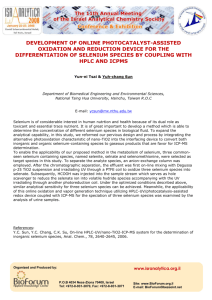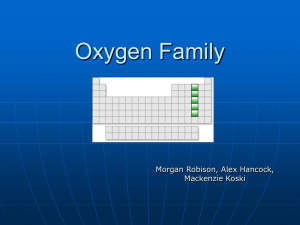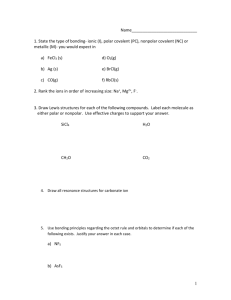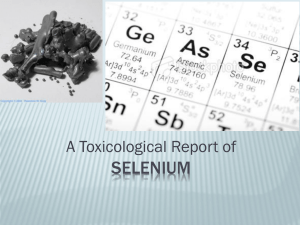Use of Decision Analysis to Model Natural Resource Management Decision Scenarios
advertisement
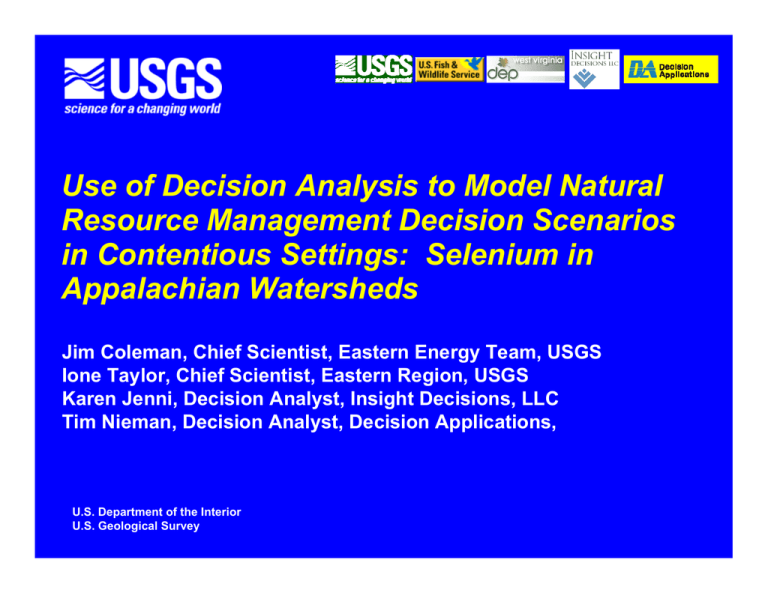
Use of Decision Analysis to Model Natural Resource Management Decision Scenarios in Contentious Settings: Selenium in Appalachian Watersheds Jim Coleman, Chief Scientist, Eastern Energy Team, USGS Ione Taylor, Chief Scientist, Eastern Region, USGS Karen Jenni, Decision Analyst, Insight Decisions, LLC Tim Nieman, Decision Analyst, Decision Applications, U.S. Department of the Interior U.S. Geological Survey The Issues at Stake • Increased demand for energy and transportation efficiency & safety • In the Appalachian Coal Basin, these demands can be addressed by large scale earth removal and grading • Currently permitted practice safeguards may not be sufficient to protect the local environment • Stopping mining & construction is not an option • Unregulated mining and construction is not an option Contentious Setting • Increased energy demand in the US from late 1990’s to the present led to increased coal mining to supply energy for electricity to meet the call for “energy independence in the US.” • Surface coal mining operations were scaled up significantly to meet the demand. • In 2002 USEPA found that Selenium concentrations from valley fill sites (where coal mining wastes were deposited) were found to exceed Ambient Water Quality Criteria (AWQC) for selenium at 13 of 15 sites. • The existence of selenium at these concentrations indicates a potential for adverse impacts to the aquatic environment and possibly to higher order organisms that feed on aquatic organisms. • Fish collected from one lake downstream of an extensive mining complex in West Virginia were found to contain selenium concentrations much higher than would be expected to occur naturally. (http://www.epa.gov/region3/mtntop/pdf/IV_Environmental%20Consequences.pdf) Contentious Setting (cont.) • An EPA study conducted as part of the Mountaintop Mining/Valley Fill EIS found that selenium in streams below valley fills exceeded the aquatic wildlife standard of 5 μg/L. • USFWS analyzed fish tissues collected downstream from mountaintop mining areas. – Selenium was present in all sampled tissues. – At several locations Se in tissues exceeded 4 mg/kg (ppm), a concentration that can result in reproductive failure and juvenile mortality. – Se in some tissues approached 7 mg/kg, a concentration that can result in reproductive failure in birds consuming these tissues. (Evaldi and others, 2002) Additional Factors • Federal funding of major interstate-style freeways in Appalachia was initiated in 1964 to reduce the region’s isolation and improve regional economic potential; it continues today. • With increased market accessibility and regional development funding, large footprint industrial and commercial activities have been developed. Net Result • More jobs • Greater cash flow (for individuals, corporations, and states) • Major and permanent changes in the regional landscape and culture • Increased potential for adverse effects on the region’s environment and human health ? g n i d n a t s A Possible Pathway toanaUSolution nder • Application of Decision Analysis involving integrated scientific analysis with key input from subject matter experts, decision makers, and stakeholders • Development and modeling of alternative scenarios to test the implications of specific management decisions Some definitions • Decision – An irrevocable allocation of resources • Decision-maker – A person (or group of people) who have the authority and the power to make a (the relevant) decision • Stakeholders – People who have an interest in a particular decision, people who can influence a decision, and people who are affected by that decision. Decision Analysis (DA) • One of many Structured Decision Making “tools” to help decision makers make better decisions. Decision Analysis (DA) • An overall approach for making logical, reproducible, and defensible decisions in the face of technical complexity, uncertainty, and multiple, possibly competing objectives; • A process to bring customers and endusers into the initial design process; • A set of tools for structuring and analyzing complex decision problems. DA modeling steps 9Problem framing – Identify decision makers, stakeholders, scope, and key components of the decision problem 9Structuring and modeling – Identify how the pieces of the decision problem fit together 9Quantification – Quantify uncertainties and impacts on objectives 9Analysis and sensitivity analysis Scope of the Challenge large scale surface mining large scale construction large scale road building Scope of the Challenge Selenium in West Virginia • Selenium (Se): – Healthful at certain dosages; Harmful at higher (or lower) dosages – “Selenium has the narrowest band of any toxic chemical between what’s safe and what’s toxic.” (Skorupa, 1993*) • West Virginia (WV): – Se is present within the coal-bearing section in eastern USA coal fields of WV & neighboring states – Se could be liberated by significant ground disturbances including large-scale surface mining, road construction, industrial & urban development ongoing in area *http://www.sci.sdsu.edu/salton/SeTooMuchTooLittle.html Pertinent Selenium Levels • NIH RDA = 0.055 mg/day/person • Toxic human levels = 30 – 60 mg/day • Lethal human dose (median) = 1.5 – 60 mg/kg body wt/day • Maximum Contaminant Level (MCL) in water = 0.05 ppm = 5 ppb • Proposed max. Se conc. in fish = 7.91 μg/g (dry wt.) = 7.91 ppm • Human Health Advisory = 8 ppm in fish (levels from Andreotti, 2003; EPA, 2004; NIH, 2004; DHHS, 2003; DOI, 1998) Geographic Distribution of Se in WV Coals n = 845 http://www.wvgs.wvnet.edu/www/datastat/te/Maps/Semapmax.gif Mountaintop mining in southern West Virginia http://www.ohvec.org/galleries/mountaintop_removal/007/index.html Hobet 21 Mountain-top Mine Dragline (photos courtesy of Jon Kolak, USGS) Hobet 21 Mine Valley-Fill & Sedimentation Pond (photos courtesy of Jon Kolak, USGS) US 119 (Corridor G) Cut-and-Fill Cut > Fill (image from USGS Terraserver.com) US 119 Road Cut (photo courtesy of Jon Kolak, USGS) Charleston WV – Yeager Airport Runway Safety Apron Extension http://www.yeagerairport.com/files/WEB-5-Construction-Early-Oc.jpg Identification of Stakeholders, Decision Makers, and Key Decisions • Stakeholders: utilities, utility customers, local landowners, potential users of reclaimed land, agricultural interests, communities and concerned local residents • Decision Makers and Types of Decisions: regulators, community planners and development agencies, coal companies, research funders and research agencies, special interest groups, permitting, leasing, allocation of resources • Specification of Objectives: maximize positive effects; minimize negative effects Potential Decision Makers and Types of Decisions Decision maker Regulators - State environmental protection dept - U.S Environmental Protection Agency - U.S. Army Corp of Engineers - U.S. Fish and Wildlife Service - U.S. Office of Surface Mining - Various surface management agencies Community planners and development agencies - Land use planners - City planners - Local/regional economic development agencies - County commissioners Coal companies Research funders and research agencies - U.S. Congress (appropriations) - USGS Special interest groups - Environmental activist groups - Conservation groups - Fishing and hunting organizations Types of decisions made - Leasing - Standard setting (e.g., regulatory standards for maximum Se concentrations in environment) - Permitting - Required mitigation measures - Conduct EIS - Invest in further studies - Regulation enforcement (what regulations, where and when to enforce) - Land use and development practices - Zoning restrictions - Political and economic development plans - Whether to pursue a given resource Types of coal/conditions under which to pursue Mining practices Which studies to fund - Allocation of resources Model Objectives The model is set up to address in detail two objectives: 1. “Minimize harm to public health” by inclusion of several outputs directly related to public health impacts, and 2. “Minimize harm to ecosystems (non-human biota)” by inclusion of outputs directly related to biological effects of selenium in ponds and streams. Other objectives were discussed during problem framing, but were not (yet) modeled quantitatively Strategy Table for Mine Permitting Decision: strategy table, with four possible strategies developed from linked responses. “No worries” strategy – no worries about potential Se impact - no changes to the current permitting decision process required “Monitoring-intensive” strategy - increased testing for and monitoring of Se “Rely on special handling” strategy - special handling of high-selenium materials, but few other changes “Conservative” strategy - most conservative or restrictive option for all decisions. (Special Handling model input: triangular distribution of 90%:95%:97% Se removed from shale) Technical and scientific uncertainties exist at every stage of the selenium “life cycle” • How much Selenium is present in the geologic strata? • How much Selenium-bearing strata will be disturbed? • How is Se mobilized during and after the land disturbance? • How does Se move through the environment into surface waters? • How is Se taken up and bio-concentrated by flora and fauna of the region? • What impacts does Se have on plants and animals? • What are the possible effects of Se on human health? Selenium Model: Movement of Se from Surface Disruptions in E. USA Hydrogeology Geology Hydrochemistry Biology Human Health Geography Schematic path of Selenium from rocks to humans Selenium Model: Concentration in Rock Original Se Concentrations in Rock Total Se conc in overburden Se conc by form and lithology Partition of Se overburden by form and lithology Selenium Model: Movement of Se from land disturbances in the Eastern U.S. Disturbance Characteristics Disturbed Volume Disturbed Volume over time Map Area of Disturbed Volume Map Area of Disturbed Volume over time Disturbance scenarios Time to reclamation Percentage of coal removed Percentage of bk shale spec handled Percentage of bk shale spec handled Double Click to open any node or module Mass of Se disturbed by form Size of remaining disturbed by lithology and time Permitting strategy Percent of disturbance by lithology Lithology Functions and Indexes Se conc in pond particulates in effluent Se conc in toe effluent over time Mobilization in Fill Disturbance Lithology of disturbed Percentage of coal left for fill Original Se in Rocks Technical Analyses Se conc by drainage in surface water Se conc in pond effluent Pond Partitioning & Impacts Economic Impacts Stream Partitioning & Impacts Summary of Impacts Other Impacts Within this software you specify everything within these windows. This is where the modeling is actually done. It shows inputs and outputs. You specify how each node works in the model. Simplified, illustrative food web used to develop a model for selenium uptake by biota in a pond. * Examples might be: caddisflies, crane flies, mayflies, midges, damselflies, etc Particulate, detritus, algae Invertebrate 1* (water column feeder) Invertebrate 2** (suspension feeder) Stonerollers ** Example might be: corbicular clam Mallard Sunfish Mammals (e.g., raccoon) Bass Pond Partitioning of Se Pond Partitioning of Se Mass Se released from fill Pnd: P(health Conc loss from inflow to pond water Portion of outflow as partic Dissolved Se conc in pond by form Mass partitioning Mass of particulates leaving pond Pnd: P(Risk in humans) Total Dissolved Se conc in pond Pond Kd Conc in particulates advisory) advisory)children child & pregnant &women pregs Pnd: Safe amt fish to eat Biological Impacts Pnd: Sunfish defects Pnd: Bass defects Pnd: Mallard egg defects Kd = partitioning coefficient for Se Human Health Impacts Wildlife Impacts Modeled Results 25 Se Concentration in Bass 22.5 17.5 15 12.5 10 7.5 5 2.5 0 5 Key 10 15 20 25 Time (yrs) 30 35 40 45 50 Permitting strategy No special handling Special Handling 0.225 Se Concentration in Mallard Eggs 0.2 0.175 0.15 0.125 0.1 0.075 0.05 0.025 0 0 5 Key 10 Permitting strategy No special handling Special Handling 15 20 25 Time (yrs) 30 35 40 45 50 0.6 Pnd: P(health advisory) child & pregs (%) 0 Pnd: Mallard egg defects (%) Conc in bass (ppm) 20 Probability of Health Warnings 0.5 0.4 0.3 0.2 0.1 0 0 5 Key 10 15 Permitting strategy No special handling Special Handling 20 25 30 Time (yrs) 35 40 45 50 What we knew before we started: Appalachian Coal Basin Stratigraphy & Geochemistry Local Surface Water Chemistry Western BRD Experience with Selenium National Biological Research Capabilities Se take-up by eastern biota >> plants to fish National Biological Capabilities Se species transfer potential to biota >> water to biota Western BRD Experience Se mobilization potential >> rocks to water Surface Water Chemistry Coal - Basin Stratigraphy What we need to know now: Se take-up by eastern biota >> fish to humans Coal-bearing Stratigraphy Develop and Implement Collaborative Plans to Bridge Across Our Core Capabilities Se take-up by eastern biota >> fish to humans National Biological Capabilities Se take-up by eastern biota >> plants to fish Western BRD Experience Se species transfer poten-tial to biota >> water to biota Surface Water Chemistry Se mobili-zation poten-tial >> rocks to water What we need to do: Coordinated Plan to Fill in the Gaps Conclusions from Study While our current model has significant limitations, it appears that potential Se toxicity (as currently defined) for fish, birds, and humans in surface water downstream from large earthremoval projects can be addressed by special handling of selenium-rich material, such that at least 90% of the potentially available Se is consistently removed from the high Se-bearing material (siltstone, shale, and coal) before valleyfill disposal. Success Story: Selenium in Appalachian Coal Field Drainages • Decision makers involved in design & QC • Full spectrum of subject matter experts involved throughout project • Professional 3rd party analysts involved throughout project from initial design through QC to final roll-out • Unexpected learnings precipitated & captured >> several A-HA moments! • Tangible, actionable outcomes • Decision makers happy with final project What do you have to have to make “it” (DA) work?: • Sponsors (read managers) up and down the line, who will support you or at least not hinder you; • Sufficient resources (people, funding, time) so you don’t have to timeshare, beg, borrow, or reconfigure; • Commitment to a (reasonably) common vision and definition of “success”; • REAL subject matter experts; and • Professionally trained analysts who can integrate, facilitate, emulate, collaborate, communicate, and celebrate. Acknowledgments • USGS – GD: Blaine Cecil, Jim Luppens, Allan Kolker, Jim McNeal, Tim Rohrbacher, Sandy Neuzil • USGS – WRD: Hugh Bevans, Doug Chambers • USGS – BRD: Pete Albers, Theresa Presser • USFWS – Joe Skorupa • USEPA – Elaine Suriano • WVDEP – Pat Campbell, George Jenkins, Nick Shaer, Lewis Halstead • USGS Science Impact Center for Visualization – Wil Orr (Prescott College)
